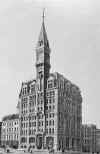 |
New York
Architecture Images- Gone New York Tribune Building |
|
architect |
Richard Morris Hunt |
|
location |
Park Row |
|
date |
1875 |
|
style |
Historicist Skyscrapers |
|
construction |
brick 260 feet tall |
|
type |
Office Building |
|
|
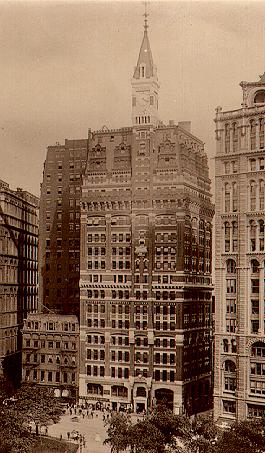 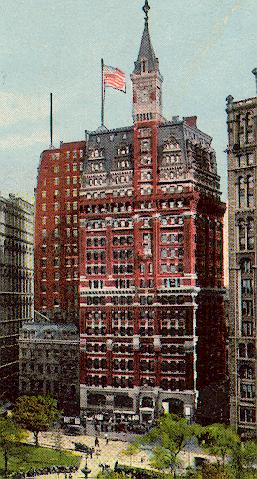 |
|
images |
 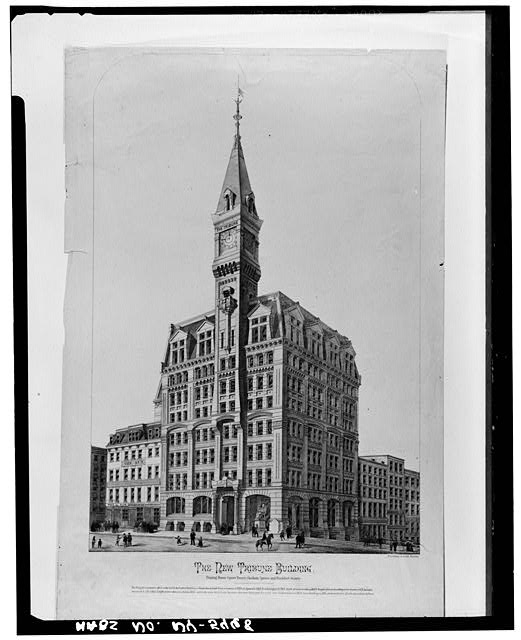 |
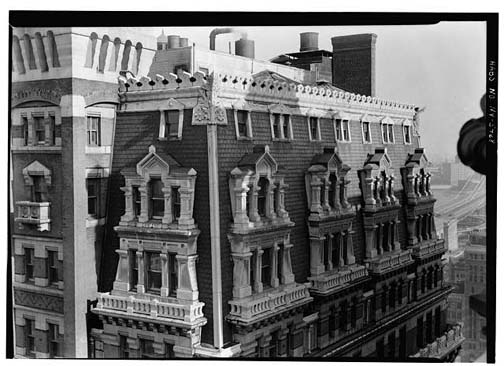 |
|
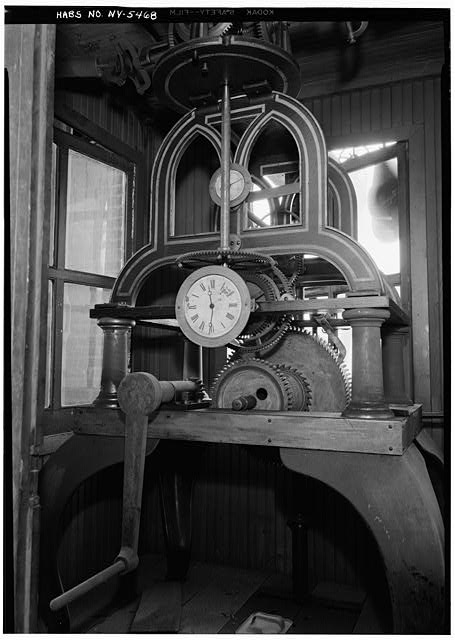 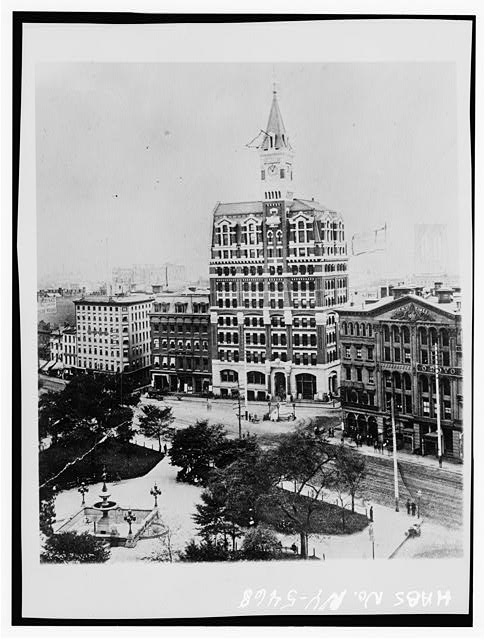 |
|
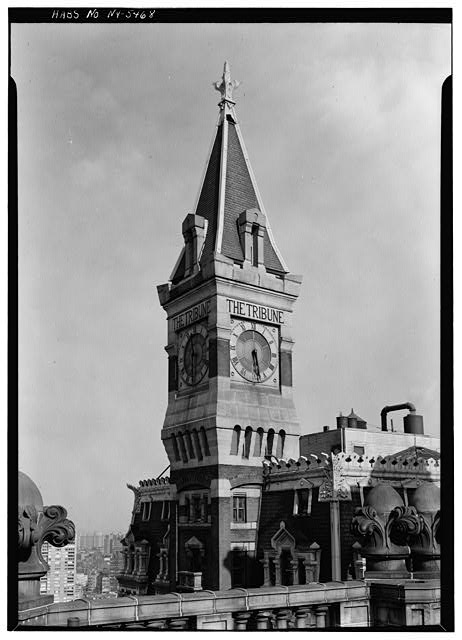 |
|
|
|
Brooklyn Bridge Entrance Ramp - former site of the World Building and the Tribune BuildingLocated on Park Row – where the access ramps to the Brooklyn Bridge are now located – the New York World Building, the Tribune Building, and the extant New York Times Building formed a triumvirate of high-rise headquarters for major news organizations. These prime sites on Park Row, across from City Hall, placed these organizations at the center of political New York. One of the first high-rise elevator buildings was Richard Morris Hunt's 1874 Tribune Building, a brick and masonry structure topped by a distinctive clock-tower and spire. Its height was increased several stories in later additions. Completed in 1890, the World Building, (also known as the Pulitzer Building) was commissioned by editor Joseph Pulitzer as a headquarters for his paper the New York World. Designed by the prolific skyscraper architect George B. Post, it was the first building in New York to surpass in height the 284-foot spire of Trinity Church. The number of stories is disputed: estimates range from the 26 stories claimed by the World to the 16 or 18 suggested by recent scholars. The World and Tribune buildings were demolished in 1955 for the expanded automobile entrance to the Brooklyn Bridge. |
|
notes |
Described at
the time as "the highest building on Manhattan Island," but the spire was
shorter than that on Trinity Church (285 feet). While metal columns and
beams supported interior floors, the exterior walls were masonry.
Downtown was the world’s media capital By Stephen Wolf Sometimes I forget that New York began Downtown, that once there was no Upper East Side or Upper West Side but only the East Side and West Side, that a thriving metropolis of 125,000 people was pressed below Canal St. while to the north lay forests and meadows, stream, swamps, and country homes for the wealthy. The towers of the Brooklyn Bridge appear old enough to have been built by the slaves of a pharaoh, but I forget sometimes that people once lived and worked where the ramps to the bridge are now, that those ramps replaced what once was the tallest building in the world, the New York World Building, completed in 1890 and from where the World was published. Under the ownership of Joseph Pulitzer, it was one of the most important papers in the city. Nearby, near Franklin Square —renamed from St. George’s Square in 1817 to honor Ben Franklin whose headstone said simply “Printer” — stood the House of Harper’s that published Harper’s Weekly and Harper’s Magazine. It makes me think community papers like this one follow a tradition in New York journalism nearly as old as the city itself. Newspapers were published Downtown long before the Revolution, before New York was an American city. In 1725, William Bradford (of Plymouth Plantation) published the New York Gazette at 81 Pearl St. He is buried in Trinity Cemetery. Not far away on Broad St., between Water and Front, the New York Journal, with John Holt as editor, was a strong voice for these colonies’ independence. At 53 Liberty St., the Evening Post was published for thirty years, and Samuel Loundon’s American Magazine had its offices at 2 Broad St. Around the corner, at 113 William St., the author of the first truly American literature was born in 1783. It was Washington Irving who wrote the “Knickerbocker Tales,” the first history (however fictional) of New York, a place he called “Gotham,” and when Rip Van Winkle woke from his long nap he found more than his beard grown long and his flintlock rusted; he found that he lived in a new, free country where Irving published his first articles in the Morning Chronicle at Pine St. off Pearl. Herman Melville was born at 6 Pearl St. in 1819, and though Ishmael shipped on the Pequod out of Nantucket, the imagination of the author of the greatest American novel of the 19th century was first drawn to the sea where elegant, mighty ships sailed through the distant Narrows toward Battery Park. Back then, the Morning Post, run by Horace Greeley, was the first low-priced daily in town. There was a time when, along Park Row where it joins Centre St. (still spelled the English way since the city was theirs when that street was laid) it was an area known as “Newspaper Row.” From 1840 until the beginning of the next century, nineteen different newspapers were published along those few blocks when the city’s population was merely a sixth of what it is now. And just a block from there is Nassau St., the most important street in the history of New York journalism. The Mirror appeared at 107 Nassau in 1823, and it had a long, successful career even after one of its editors, Nathaniel Wills, moved a few doors down to 118 Nassau where, with Henry Jarvis Raymond, he founded the New York Times. The Ledger, once at Spruce and Williams, moved next door to 119 Nassau. The New Yorker was first published at 127 Nassau, and at 142 Nassau the human rights activist Lydia Maria Child published her influential anti-slavery articles from 1841 until 1849 when the neighborhood was known, appropriately, as “Printing House Row.” Around the corner at William St., William Randolph Hearst published New York America and the New York Evening Journal. The Morning Advertiser, the Mail and Express, and The Recorder all appeared in the area, while the nearby Globe and Commercial Advertiser had been publishing as early as 1797. The Sun Building — still standing on Chambers St. – published the Sun, though not the present paper with the same name and logo. It became the first penny paper in town, published at 177 Nassau in 1868 and for the next fifty years, and when editor Benjamin H. Day sent out boys to sell the Sun to whomever would buy it, the newsboy was born. The beautiful Tribune Building stood nearby, home to the Tribune, one of the most important papers in the city and the first publishers of journalists like Carl Schurz, William Dean Howells, Henry James, and Margaret Fuller. But the Tribune tower was torn down in 1975, and like the old Penn Station, we lost a treasure. The New World Building, once known as the “World Tower,” was demolished in the early 1950s to make way for new approaches to the Brooklyn Bridge. Where “Newspaper Row” once thrived is now the campus of Pace University, and though the present always replaces the past and too often we forget what came before, one building remains as a testament and monument to New York’s great newspaper history. In 1801, Alexander Hamilton published the Evening Post, later edited by William Cullen Bryant from where he made the first cries for park space amid the visionary, merciless plan for Manhattan’s grid. Eventually, his editorials led to Central Park. After that, the Post moved to the recently completed Garrison Building at 20 Vesey St. in 1907, and though the paper published there only for another twenty years, the building still incarnates New York’s journalistic past. The spandrels of this building display well-known printers of the 16th and 17th centuries, and statues on the ninth floor preserve “The Four Periods of Publicity”: the Spoken Word, the Written Word, the Printed Word, and the Newspaper. The building may not stand forever, but the tradition of New York journalism lives in the small papers still thriving in what was once the true center of our city. |
|
Horace Greeley founded the New York Tribune
in 1841. Greeley took a strong moral tone in his newspaper and
campaigned against alcohol, tobacco, gambling, prostitution and capital
punishment. However, his main concern was the abolition of slavery and
the introduction of universal suffrage. |
|